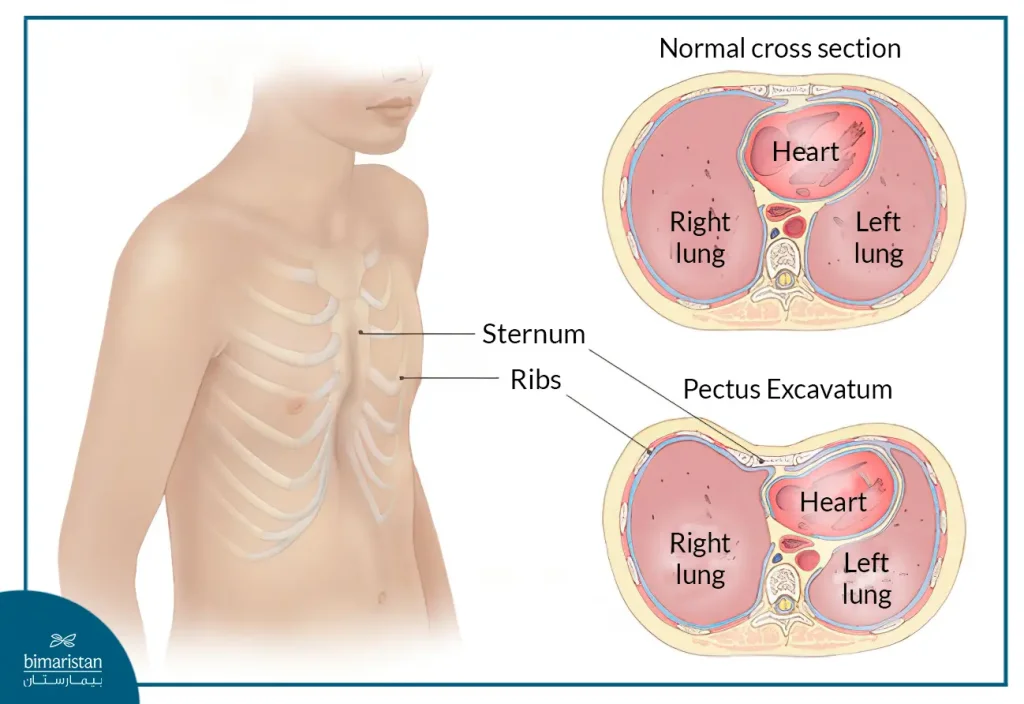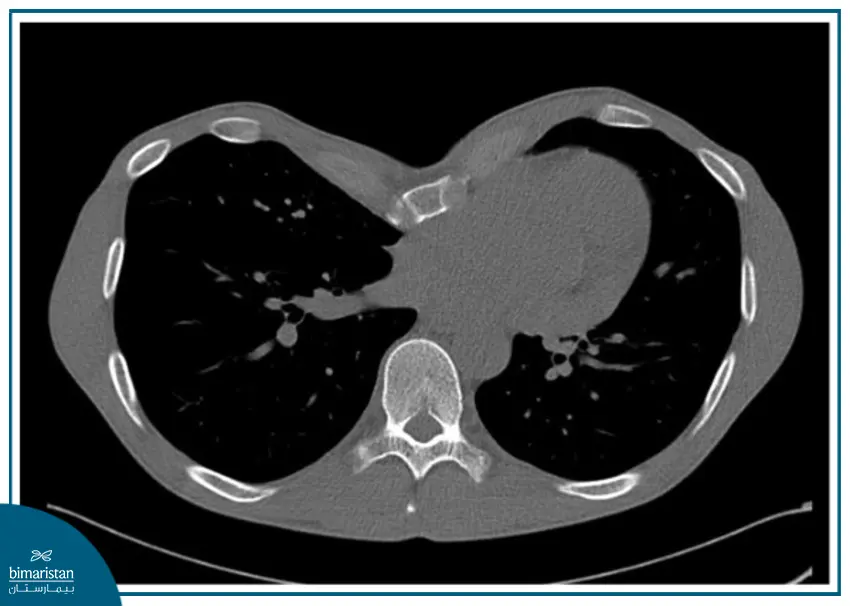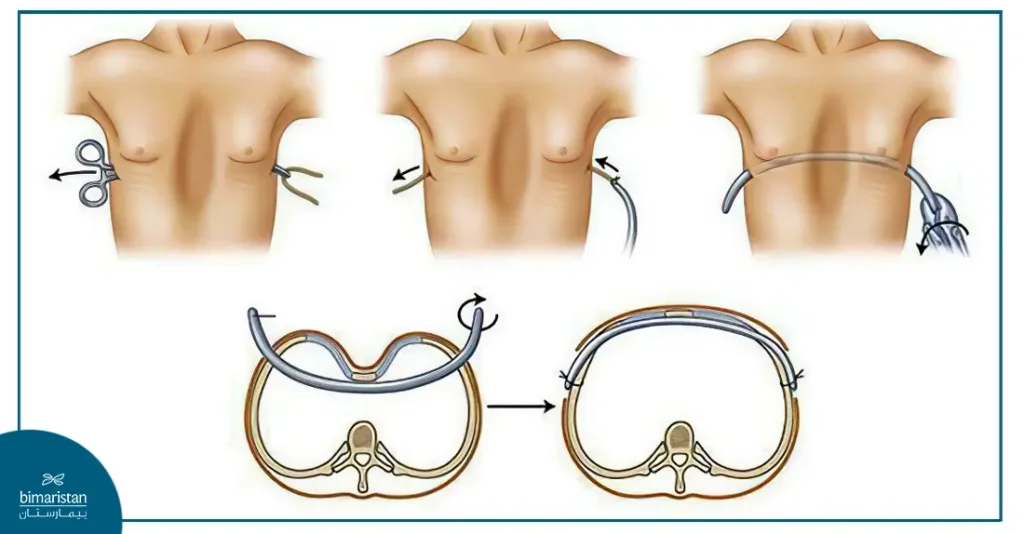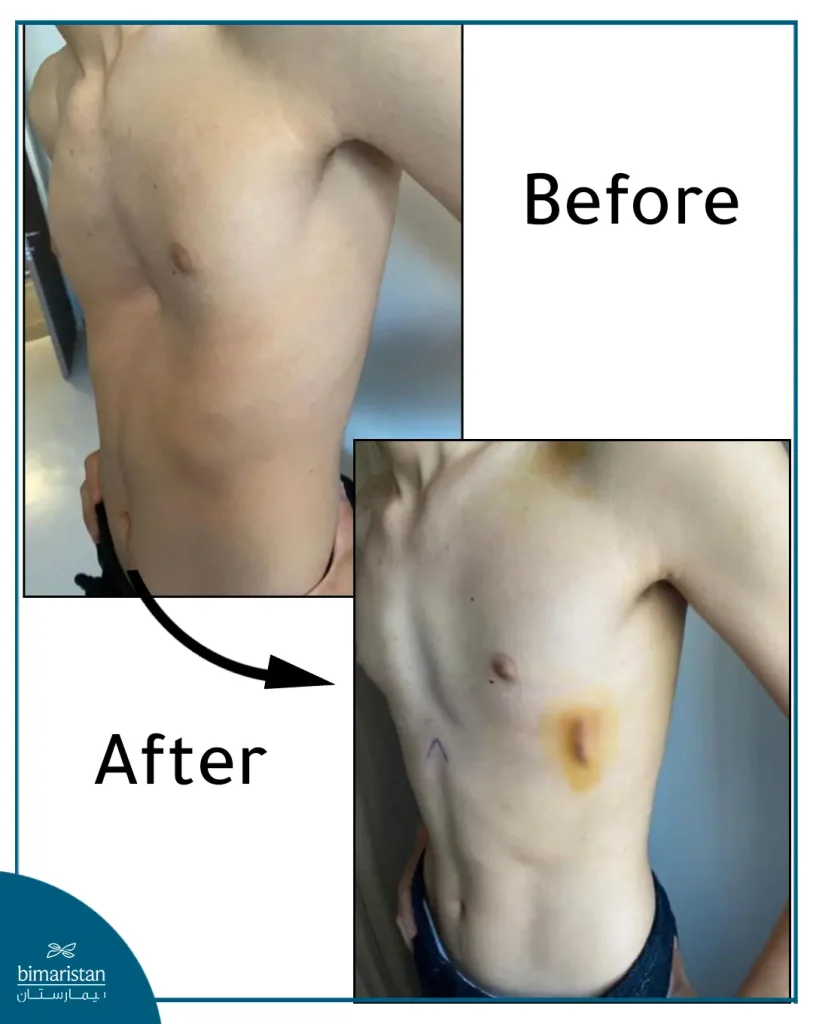Pectus excavatum is an abnormal development of the chest where the sternum grows inward, creating a depression in the chest wall. Learn about the treatment methods for pectus excavatum in Turkey.
Pectus excavatum, also known as sunken chest or funnel chest, is one of the most common congenital deformities in the chest area. It can occur in both children and adults, but may not be evident in children due to incomplete growth of their chest bones, often becoming more noticeable in early teenage years. Adults are often aware of their chests for many years before seeking treatment in Turkey.

Symptoms of pectus excavatum
Congenital pectus excavatum results in reduced space in the chest, limiting the functions of the heart and lungs. Common physical symptoms of Sunken chest include:
- Shortness of breath during physical activity
- Decreased exercise tolerance compared to peers
- Fatigue
- Chest pain
- Irregular heartbeat
Pectus excavatum may also cause some psychological symptoms such as:
- Embarrassment about the appearance of the chest
- Low self-esteem
- Depression
Uneven chest protrusion may lead to breathing problems and posture issues and possibly affect your body confidence.
Causes of concave chest
Causes of chest pectus excavatum include:
- Injuries and trauma: If a significant amount of time has passed since the injury, your ribs may require surgery to restore symmetry. If the injury is recent, you can consult a thoracic surgeon to evaluate your condition and assist with recovery.
- Congenital defects: You may have a deficiency in one of the ribs, or the chest wall may naturally be expanded since birth.
- Rib cartilage abnormalities: Affect approximately one in 1,500 children, causing either protrusion (pectus carinatum) or depression of the chest wall. Most of these deformities are corrected using a brace, but some may require surgery.
- Muscle weakness: Abdominal muscles play a significant role in stabilizing the chest wall. If muscles on one side are weaker than the other, it may cause one side of your chest wall to protrude.
- Scoliosis: The curvature of the spine towards the right or left. The chest wall may adapt to this position and become uneven.
Diagnosis of Pectus Excavatum in Turkey
Pectus excavatum can be diagnosed through a simple physical examination in Turkey. Often, the defect may not be noticeable until early teenage years.
More detailed examinations such as MRI chest imaging or CT-scan and testing heart and lung performance provide accurate measurements of the severity of pectus excavatum and its impact on heart and lung functions.
An echocardiogram and pulmonary function tests (PFT) can also be performed to evaluate physical symptoms of pectus excavatum.

Treatment of Pectus Excavatum Without Surgery
Although the chest does not complete its growth and take its final shape until adolescence, parents may notice a slight hollow at the front of their child’s chest during their growth, leading to concerns about the occurrence of pectus excavatum in the child in the future.
However, the occurrence of pectus excavatum in a child cannot be confirmed without consulting a specialist doctor and monitoring the child’s chest over a period of time.
Anyway, pectus excavatum in a child under 8 years old can be treated without surgery using a modern method called Vacuum Bell, which is a rubber suction device available in several sizes based on the child’s age and the severity of the chest depression.

Steps for using the Vacuum Bell device:
- Place the device at the front of the chest so that its center is aligned with the deepest point of the depression.
- After securing the device, the patient sucks air into it using a manual pump, causing the device to pull the front of the chest outward.
- The device remains on the patient’s chest for a few hours and is then removed.
- Repeat this process every day for at least one year.
There are no long-term studies on the effectiveness of Vacuum Bell in treating pectus excavatum in children, but individual experiences have been published in some medical journals from patients who had a sunken chest and felt satisfied after using this device.
Treatment of Pectus Excavatum in Turkey
Pectus excavatum is treated surgically in Turkey, with the primary goal of correcting the chest deformity to improve the patient’s respiratory and cardiac function. After repositioning the chest, pressure on the heart and lungs decreases, allowing them to function normally.
The external appearance of the chest is significantly improved after the operation, eliminating all psychological damage caused by chest deformity that may contribute to the patient’s distress.
Pectus excavatum can be treated using a minimally invasive surgical technique called the “Nuss Procedure” or through traditional surgery known as “Ravitch Procedure”. Your surgeon will discuss the most suitable procedure for your case based on several factors.
Nuss Procedure
In this procedure, the surgeon makes two small incisions on each side of the chest, each about 4 cm long. A curved steel bar (designed to be specific to each case) is then inserted under the sternum to correct the depression and secured to the chest wall with special fasteners on both sides.

The doctor then closes both incisions with absorbable sutures. This technique is called “minimally invasive pectus excavatum correction” because it is done through two small surgical incisions on each side of the chest, unlike traditional surgery that requires a large surgical incision in the center of the chest.
The procedure generally takes between one and two hours depending on each case and is a very simple operation rarely associated with complications. The bar is left in place for 3 years and later removed in outpatient clinics. Watch a video of pectus excavatum correction surgery here.
Although the procedure was initially performed for children, it is now possible to perform it for adults as well.
Ravitch Procedure
Also known as the “Traditional or Open Surgical Repair of Pectus Excavatum,” the Ravitch Procedure involves making an incision in the front part of the chest and removing the enlarged cartilaginous part of the ribs that pushed the sternum backward.

This procedure allows pulling the sternum forward away from the heart and lungs to reach the normal level of the chest wall.
Often, a small plate with screws is used to secure the sternum in its new position, or alternatively, a small metal bar can be placed behind the sternum to hold it in place for 6-12 months. The bar is later removed through a simple procedure in outpatient clinics.
The metal bar used in the Ravitch Procedure is smaller than the metal bar used in the Nuss Procedure.
Recovery after Pectus Excavatum Correction Surgery
There is a new method to reduce severe pain after the Nuss procedure called Cryoablation by freezing the intercostal nerves that transmit pain sensation in the chest wall before starting the operation instead of performing epidural anesthesia.
Recent studies indicate that Cryoablation during Pectus Excavatum correction surgery significantly shortens hospital stay and reduces the amount of opioid painkillers used compared to traditional epidural anesthesia.
Usually, patients undergoing the Nuss procedure require hospitalization for a week after surgery when using epidural anesthesia, followed by several weeks of opioid medication use after discharge, which is a source of concern considering that opioid therapy may increase the risk of addiction.
With Cryoablation, most patients can now return home the day after surgery. Some patients do not need to use any intravenous or oral opioid medications in the hospital, and those who feel pain after surgery usually stop using oral opioid medications within one to two days.
Before the Cryoablation-supported Nuss procedure, the required recovery period – which was a month or more – pushed school-age patients to exclusively undergo surgery during the summer to avoid missing school. Now, shortening hospital stay and recovery time gives patients more flexibility in scheduling their surgery during winter or spring breaks.
Benefits of Surgical Correction for Pectus Excavatum in Turkey
The goal of correcting and treating thorax excavatum is to relieve pressure on the heart and lungs; surgical repair usually leads to chest pain relief, improved breathing, and increased exercise tolerance.
It is natural for patients suffering from Pectus Excavatum to believe that their breathing and exercise tolerance were normal before surgery, but they realize they are significantly better afterward.
In patients whose main problem lies in the appearance of their deformed chest, there have been radical positive changes in their self-esteem and confidence, with complete healing observed in depressed patients who could stop taking antidepressant medications they were previously on.
Both the Nuss and Ravitch procedures yield excellent results, and patients always feel satisfied with the final appearance of their chest after recovery. The recurrence rate for both procedures is less than 1%.

Risks of Pectus Excavatum Correction Surgery
Surgical repair for caved in chest carries risks like any other surgical procedure. Although both the Nuss and modified Ravitch techniques are safe and effective procedures, complications may rarely occur when performed by an inexperienced surgeon.
Possible complications of surgical repair for Pectus Excavatum include:
- Bleeding
- Injury to surrounding structures
- Chest infection
- Pneumothorax
- Displacement of the steel bar
- Recurrence of Pectus Excavatum after bar removal
In conclusion, there is no evidence that Pectus Excavatum reduces life expectancy or causes increasing harm to the heart and lungs over time. However, patients are expected to experience more symptoms over time. This may be due to aging and increasing difficulties in compensating for functional impairments associated with Pectus Excavatum; however, this does not mean that damage will necessarily occur.
The cost of Pectus Excavatum surgery in Turkey ranges from 4-12 thousand US dollars, and this cost is much lower than in Europe and America. Of course, the price varies from patient to patient based on their health condition, the appropriate procedure for them, and the tools used. Contact us for a free consultation to determine the final price for your case and learn all the details related to undergoing Pectus Excavatum correction surgery in Turkey.
